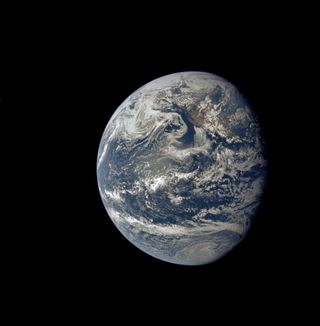Apollo 11 Flight Log, July 18, 1969: Entering the Moon's Gravity
Click unmute on the video above hear mission audio from Flight Day 2 of the Apollo 11 mission and listen to over 50 minutes of audio in the video from NASA below.
Fifty years ago today (July 18), the Apollo 11 astronauts were allowed an extra hour of sleep. This day, the crew completed a number of objectives, including checking on the Eagle and entering lunar orbit. Here's how it happened.
On the second day of their historic mission to land on the moon for the first time, the Apollo 11 crew of Neil Armstrong (commander), Mike Collins (command module pilot) and Buzz Aldrin (lunar module pilot) received a small gift from Mission Control: the privilege to sleep in for an extra hour.
Rest would be needed as the crew busied themselves for the moon landing on July 20, 1969, just two days away.
- Apollo 11 at 50: A Complete Guide to the Historic Moon Landing
- Relive the Apollo 11 Moon Landing Mission in Real Time
- Apollo 11 Moon Landing Giveaway with Simulation Curriculum & Celestron!
Speeding towards the moon in their spacecraft Columbia, with the lunar module Eagle docked for the landing, the astronauts fully expected they would need to perform another course correction to make sure they got to the right orbit around the moon. Mission Control informed them, however, that the maneuver was not needed because the spacecraft were flying exactly where they needed to.
Going to the moon not only depended on the success of their orbiting spacecraft Columbia, but also on how well the lunar craft Eagle would perform. The astronauts got the chance to check out Eagle that afternoon during a scheduled television broadcast.

While sending a transmission from 201,000 miles (323,500 kilometers) from Earth and about 55,200 miles (88,800 km) from the moon, the Apollo 11 crew opened the hatch to Eagle. Armstrong moved through the 30-inch (76-centimeter) wide tunnel with Aldrin behind him, looking at the spacecraft to see how it fared after the launch.
Get the Space.com Newsletter
Breaking space news, the latest updates on rocket launches, skywatching events and more!
The crew went to bed around 10 p.m. EDT (0200 July 19 GMT) that evening. An hour later, the spacecraft passed from the gravity of the Earth to the gravity of the moon at just 10 percent of the speed achieved when Columbia broke Earth orbit. The crew was on its way to a July 20 moon landing at a speed of about 2,040 miles per hour (3,280 km/hr).
You can catch up with anything you missed from the historic flight by reading Space.com's first two Apollo 11 flight log entries for launch day on July 16 and a course correction on July 17.
Editor's note: This feature, originally posted in 2014, has been updated for the 50th anniversary of the Apollo 11 mission. Space.com contributor Chelsea Gohd contributed to this report.
Follow Elizabeth Howell @howellspace. Follow us @Spacedotcom, Facebook and Google+. Original article on Space.com.
Join our Space Forums to keep talking space on the latest missions, night sky and more! And if you have a news tip, correction or comment, let us know at: community@space.com.

Elizabeth Howell (she/her), Ph.D., is a staff writer in the spaceflight channel since 2022 covering diversity, education and gaming as well. She was contributing writer for Space.com for 10 years before joining full-time. Elizabeth's reporting includes multiple exclusives with the White House and Office of the Vice-President of the United States, an exclusive conversation with aspiring space tourist (and NSYNC bassist) Lance Bass, speaking several times with the International Space Station, witnessing five human spaceflight launches on two continents, flying parabolic, working inside a spacesuit, and participating in a simulated Mars mission. Her latest book, "Why Am I Taller?", is co-written with astronaut Dave Williams. Elizabeth holds a Ph.D. and M.Sc. in Space Studies from the University of North Dakota, a Bachelor of Journalism from Canada's Carleton University and a Bachelor of History from Canada's Athabasca University. Elizabeth is also a post-secondary instructor in communications and science at several institutions since 2015; her experience includes developing and teaching an astronomy course at Canada's Algonquin College (with Indigenous content as well) to more than 1,000 students since 2020. Elizabeth first got interested in space after watching the movie Apollo 13 in 1996, and still wants to be an astronaut someday. Mastodon: https://qoto.org/@howellspace

